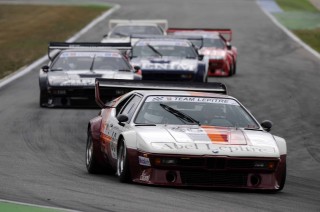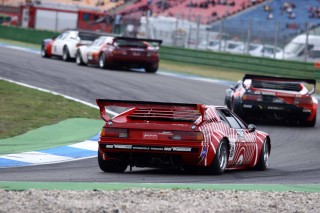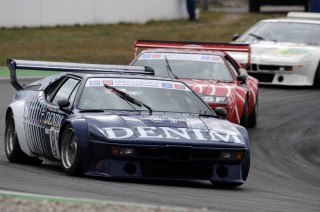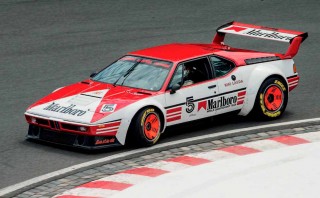Support Act M1 PROCAR
Legendary BMW drivers tell all
Like so many good ideas, this one began with group of friends drinking in a bar. After several beers and one whisky too many, the men around the table struck upon the idea of a one-make racing championship for BMW’s troubled M1 sports car. Amongst those at the table and buying the rounds at the nondescript bar in Munich were Max Mosley, legal advisor to the Formula One Constructors Association, and Jochen Neerpasch, head of BMW M GmbH. Neerpasch had a problem. He had convinced the board at BMW that he should take the company into Group 4 and Group 5 sports car racing, with a new, mid-engined sports car that would bring both silverware and cash to M GmbH.

The thinking was sound. Create a racing car for the road, one that would give BMW a stronger hold on the motorsport market. For perspective, Neerpasch tells me that in 1977, the BMW Junior Team raced the 3 Series Group 5 car, which cost customers 350,000DM, a huge sum in the ‘70s and ten times the price of a road car. Whereas the M1 road car would cost 100,000DM and the race version would be 150,000DM. Presented with a sound strategy, the board approved the M1 project but soon, like an amateur race driver taking to a wet circuit for the first time, Neerpasch found himself struggling to keep the project on track. We interviewed him at Norisring, during an event held to mark the 40th anniversary of the BMW M1 Procar championship, last year. He’s happy to tell the story of what really went on behind the scenes of the M1 project. Adding a driver’s-eye view are Hans-Joachim Stuck, Jan Lammers and Marc Surer, Formula One drivers of the era who not only raced in the M1 Procar championship, but also helped develop the road car.
Neerpasch is aging well. His well-kept silver hair, smiling eyes, trim figure and tanned skin suggest that retirement isn’t treating him too badly. He takes me back to the period just before he, Max Mosely and others have the eureka moment in the bar.
“When we started on the construction of the M1, the production lines at BMW were not flexible enough that we could build the cars at BMW. So we had to look for an outside partner. We found Lamborghini, and at that time the Lamborghini factory was ideal for this; they had a production volume of 700 to 800 cars a year but they were building only 200 or so. “So it was perfect for us. The idea was to build 400 cars through the year to get the homologation in Group 4. But after they made the first five or six prototypes, we found out that Lamborghini was in financial trouble.”
“It was fair racing. There weren’t any tricks; we didn’t hit each other on purpose. It was just fun.”

Neerpasch shares how it was a classic tell that led him to believe the project was in a precarious position: suppliers were not being paid. Once word reached him, in 1978, there followed a great deal of stress for Neerpasch and his colleagues at M GmbH, as they scrambled to secure a lifeline for the M1 sports car project, and its motor racing aspirations. “The project nearly collapsed,” recalls Neerpasch.
New partners had to be found. Instead of BMW hand-building the powertrain, Dallara making the tubular steel space frame, Giugiaro delivering the bodywork and Lamborghini handling final assembly, Italina Resina made the bodies, Marchesi the chassis, then Italdesign introduced the interior before the whole lot was shipped from Italy to Germany, where Baur oversaw the final assembly. The inevitable delays introduced by such fundamental manufacturing changes meant that there was no hope of building enough M1s to homologate it for racing in Group 4, in 1979. Which is how Neerpasch ended up scratching his head in the bar in Munich, together with Mosley, pondering what on earth he could do to sell enough cars to keep the board happy and keep the brand’s motor racing ambitions alive.
“The next morning,” continues Neerpasch, “Mosley contacted Bernie Ecclestone and he thought it was a good idea for Formula One, for Saturdays [as a way of pulling in larger crowds on the day of the Procar races at European GPs]. It worked, because Bernie got double the number of spectators as normal. And as a brand-building exercise [for BMW M] it was tremendous.
“Mario Andretti said, ‘I will never drive in Procar’ and then Bernie came with a few dollars, and Mario said ‘Okay, I’ll drive’…”

“At that time F1 was not what it was today. Drivers were not only contracted to Formula One, they could drive other cars. A few years earlier, in 1974, during the European Saloon Car Championship, we had 13 Formula One drivers driving saloon cars.
“Even so, we didn’t really know if all the F1 drivers would accept to drive the cars. At the first race, at Zolder, Mario Andretti said, ‘I will never drive in Procar’ and then Bernie came with a few dollars, and Mario said ‘Okay, I’ll drive’. After that, the others followed. “Friday practice was important for them. The car was already at a high level and was difficult to drive. This is why Formula One drivers were competitive. If you had a Renault 5 Cup, and put a Formula One driver in it, there’s no difference. But this car’s already on a high level so Formula One drivers would really show their performance.
“They were not paid to take part but there was some prize money and the winner of the championship would get an M1 road car. Lauda and Piquet won the cars but I don’t know whether Lauda took his car or Ron Dennis got it.
“I think the car was very important to BMW’s legacy. The trouble is, when I left BMW in 1980, the company shifted its focus to Formula One and then they forgot about the M1; there was no development.

Neerpasch needn’t have worried about whether some of the world’s top flight drivers would willingly climb aboard an M1 Procar and do battle with F1’s finest and other, invited drivers. Word had already got out that the M1 was a rewarding car to drive. German driver Hans-Joachim Stuck takes up the story of the car’s development, before it so much as turned a wheel at a Grand Prix weekend.
“Jochen was my boss in those days. And he is the best boss I have ever had. I was educated by him; he got me under control. And the things he did in motorsport are just unique – fantastic. So when he introduced this ultimate poker series, which is it still the best cup series in the world, you know, I was positively excited.”
Part of Stuck’s excitement was down to the fact he knew the road car so intimately. He was just one of the BMW race drivers employed to rack up miles on prototypes. “To get the road proof registration, they needed to do 100,000-kilometres of constant driving in a relatively short time. So under pressure to complete the road car project, there was Marc Surer, Ronnie Peterson came and a few others.
“We had a stretch of four weeks. And we did four tours daily in the morning, where we’d drive 250-kilometres through Bavaria; come back, refuel the car, the other one went on the next stint. After every weekend we had to change the route because we were running over the over the farmers’ hens and not obeying any speed limits. It was just a fun time! “After driving it we knew the car like our baby, and we all agreed it would make a cool race car. The moment Jochen said BMW would make a race car we were on fire because the car was so nice to drive.”
Stuck raced with Cassani Racing and Project Four, the race team founded by Ron Dennis after he left Brabham. Was there any difference between the two? “You know how immaculate he was or is. But in fact, between the Cassani car and the Ron Dennis car, there was no difference. Maybe his was a bit cleaner but the performance was always was the same. When the mechanics were driving the car from the truck to somewhere they had to put these show covers on to keep the car clean!”
Stuck describes how close the racing was and how driving in Procar through both seasons gave him an advantage over guests such as Clay Regazzoni or Carlos Reutemann. “On courses like Monaco, where it’s hard to overtake if you’ve got room, when you outbraked somebody going down from the Casino, it was like heaven on earth. But it was fair racing. There weren’t any tricks; we didn’t hit each other on purpose. It was just fun.”
He and the likes of Marc Surer, the Swiss driver who’d go on to race with Brabham in Formula One, would frequently point to their results in the M1 Procar championship when negotiating over contracts and fees, or, indeed, their ability when F1 teams occasionally questioned them rather than addressed a fundamental problem with the car.
“I remember a really frustrating day with the ATS at Brands Hatch,” Surer recalls, “the team was not happy with me and I was not happy with the car. But then I went to do qualifying in the Procar and got pole position. And for me, it was so important because they doubt you, ‘Maybe the driver is not as fit as we think’, and ‘What is the problem?’ and you say ‘The car is shit’ and then you go and you sit in a neutral car and you beat all these Formula One guys who are far away in front of you in F1, and it is a moment of redemption. When you come back to the F1 team you don’t need to discuss anything!”
Did the M1 make a good race car from a driver’s perspective? Surer, who also did a lot of the development work with the road-going M1, and owned one from 1981 until 2018 – racking up nearly 90,000km before selling it – is in no doubt it did.
“The feeling you get in the race car is different; so much better than the road car. And you know what the good thing is, because of the weight distribution, and that you have no power steering, you get such a good feeling for the front tyres. It truly is mid-engine. So you don’t have too much load on the front. And so that means you don’t need to force the car into the corners; it drives into the corners as it should. And that’s why everybody likes it. When they drive it, it does exactly as you want.”
For Jan Lammers, the Dutch driver who drove Jaguar to victory at the 1988 Le Mans, the Procar championship was a chance to show he was a race winner when not in mediocre equipment. “We had Alan Jones and Carlos Reutemann and Jacques Lafitte takes us on,” he says with a twinkle in his eye, “and they were driving all those Formula One cars that we would love to drive, so as soon as we got them in our neighbourhood, we went bam!” [slaps hands]
“Racing with Hans-Stuck, I had great battles. He was always a tough guy. I was a tough guy. So we had lots of battles, but always fair and square.” However, even when he wasn’t having problems with other drivers around him, Lammers laughs about other issues he had to contend with in Procar.
One time he’d taped closed all the ventilation ducts in the cabin, in an attempt to eek out a fraction more speed from his car. It wasn’t a wise move.
“Physically, the M1 was not too bad. It’s just hot. The engine is very close to you. So taping the vents shut meant the fire extinguisher went off. And it wasn’t one of those powder fire extinguishers, it was one that sucks the oxygen away. So immediately, I felt like I was completely drunk.” Lammers passed out briefly, luckily on the straight, then woke to find he’d dropped from first to fifth. “So then I regained consciousness and I made it almost back to win, but it was like, a half a car length. It’s a story for the grandchildren!”
And that’s the thing about Procar. To this day, it remains one of motorsport’s greatest championships. For a series that came within a photo finish of never happening in the first place, its reputation lives on.
So much so, that in 2017, Christian Horner of Red Bull Racing’s F1 team spoke of how he’d badgered Bernie Ecclestone to create a modern-day equivalent to Procar. That’s quite some complement to the men who dreamed up the idea over one stein of beer too many.
The turbocharged in-line six-cylinder M88 engines put out 850bhp-1000bhp… The series gave F1 hopefuls and established names a chance to prove their worth. Norisring held the Procar Revival to mark the championship’s 40th anniversary, reuniting cars and drivers. Left to right: Surer, Stuck and Lammers. Neerpasch (right), was instrumental in the birth of the championship…





